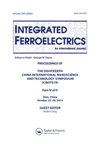Sintering Temperature Effect on Phase Formation, Microstructure and Electrical Properties of Modified KNLNTS Solid Solution Prepared via the Solid-State Combustion Technique
IF 0.7
4区 工程技术
Q4 ENGINEERING, ELECTRICAL & ELECTRONIC
引用次数: 0
Abstract
Abstract In this study, the effect of sintering temperature (1000–1100 °C for 2 h) on phase formation, phase transition, microstructure and electrical properties of lead-free piezoelectric (K0.44Na0.52Li0.04)(Nb0.84Ta0.10Sb0.06)O3 (KNLNTS) solid solution with 0.3 wt%Bi2O3 + 0.4 wt%Fe2O3 + 0.2 wt%CuO additive (abbreviate as modified KNLNTS) was investigated. Modified KNLNTS ceramics were synthesized by the solid-state combustion technique using glycine as fuel. The modified KNLNTS powders were prepared using the calcination condition of 650 °C for 2 h. The XRD pattern of all sintered ceramics exhibited a pure perovskite phase. Using Rietveld refinement to analyze the phase formation showed that the modified KNLNTS ceramics had co-existing phases of orthorhombic and tetragonal in all sintered ceramics and the orthorhombic phase increased when the sintering temperature increased. The average grain size, TO-T, Tc, Pr and Ec increased with increasing sintering temperature. At the sintering temperature of 1025 °C, the modified KNLNTS ceramic showed the best electrical properties (Cε ≈ 6745, Smax ≈0.274% and d*33 ≈ 548 pm/V). The good electrical properties of the modified KNLNTS ceramics makes them good candidates for lead-free applications to replace Pb-based ceramics.烧结温度对固态燃烧法制备改性KNLNTS固溶体相形成、微观结构和电性能的影响
本文章由计算机程序翻译,如有差异,请以英文原文为准。
求助全文
约1分钟内获得全文
求助全文
来源期刊

Integrated Ferroelectrics
工程技术-工程:电子与电气
CiteScore
1.40
自引率
0.00%
发文量
179
审稿时长
3 months
期刊介绍:
Integrated Ferroelectrics provides an international, interdisciplinary forum for electronic engineers and physicists as well as process and systems engineers, ceramicists, and chemists who are involved in research, design, development, manufacturing and utilization of integrated ferroelectric devices. Such devices unite ferroelectric films and semiconductor integrated circuit chips. The result is a new family of electronic devices, which combine the unique nonvolatile memory, pyroelectric, piezoelectric, photorefractive, radiation-hard, acoustic and/or dielectric properties of ferroelectric materials with the dynamic memory, logic and/or amplification properties and miniaturization and low-cost advantages of semiconductor i.c. technology.
 求助内容:
求助内容: 应助结果提醒方式:
应助结果提醒方式:


